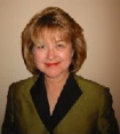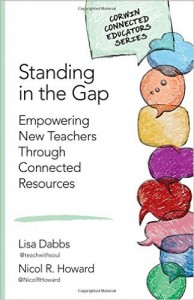Connected Resources to Empower New Teachers
Standing in the Gap: Empowering New Teachers Through Connected Resources
By Lisa Dabbs and Nicol R. Howard
(Corwin, 2016 – Learn more)

Standing in the Gap is another book in the Corwin Connected Educators Series, short books that pack a lot of information in about fifty pages (see the Middleweb review of Blogging for Educators: Tips for Getting Connected by Starr Sackstein). The theme of all of the books in this series is connectedness, defined as “an openness to sharing and learning in an entirely new environment.”

Authors Lisa Dabbs and Nicol R. Howard have impressive experience and credentials for K-12 teaching and administration, and college teaching as well, and they are well-qualified to stand and instruct in “the Gap.”
New teachers today need extra support
For years the attrition rate for new teachers has been frightening: “30 percent of new teachers leave the profession after just 3 years, and more than 45 percent after 5.” Although all teachers need a support system, these statistics point to the fact that new teachers especially need one.
No teacher is an island, separate from others. Chapter 1 tells teachers how to connect to online communities for professional development and for teaching and learning resources. Creating a bio is crucial, and Lisa Dabbs provides a sample Twitter bio. Teachers are encouraged to try Twitter, Google Plus, Instagram, TpT (Teachers Pay Teachers), and Ning (an unfamiliar community to me) sites, all available 24/7. Twitter chats are even offered on the Corwin Connected Educators companion website. Start with just one tool and practice. The teacher can also attend virtual conferences or webinars.
Making classroom connections
Chapter 2 is entitled “Making Connections Locally and Globally.” In addition to e-mail, Howard suggests Skype, Google Hangout, Facebook, Pinterest, Instagram, Twitter, Edmodo, and Schoology. She would like to see districts reaching out to other districts around the world. Action steps such as setting a time and date to connect and considering objectives and outcomes are suggested.
One fun activity from Scott Bedley, a 2014 Orange County Teacher of the Year and California State Teacher of the Year Finalist along with other awards, is a game called Mystery Skype in which two classrooms from different states connect online without knowing the other’s location. Using the process of elimination, each tries to discover where the other class is located.
Chapter 3, “Connecting to Build Your Classroom,” advocates students make contributions to the design of their classrooms. This means teachers might have to give up some control and not have a ‘ready-made classroom’ the first day of school. Teachers can use social media to travel the world and peek into other classrooms. What are the seating arrangements? What’s on the walls? Which rooms are comfortable? Let students display their work, their math, poetry, and writing, for a print-rich environment.
Lesson planning is the topic for Chapter 4. Preparing a plan is harder for new teachers, and a backwards-mapping approach looking at the whole year and mapping backwards from the end of the school year is advised. Layla Henry, M.Ed., a blogger and teacher nominated for teacher of the year in 2013, talks about her first years of teaching. She was assigned to teach ancient civilizations and mythology and became overwhelmed until she stumbled upon www.teacherspayteachers.com or TpT. When she left intermediate school for an 8-12 year-old classroom, she found links to teacher blogs and eventually started her own. Now she holds blogger meet-ups and has connected with hundreds of other teachers. The authors include steps for making a lesson plan (objective, materials, procedures, assessment, reflection).
Communication with students and parents is the topic of Chapter 5. A sense of community is important, say the authors, but today creating one is simpler because of Web-based resources like Edmodo, blogs, Wikispaces, Volunteerspot, and other resources. Connecting immediately with parents is important rather than waiting until a discipline problem arises. Dabbs even tells how to reach out to parents and students without sharing your cell number directly, and Howard suggests limiting the hours you are available. Three favorite tools are Remind.com, YouTube Videos, and a class website.
The final chapter, Chapter 6, is on finding a mentor. “Mentoring matters,” especially for new teachers. Lisa Dabbs explains how to connect to a virtual mentor or even to sign up to become one. And don’t be afraid to have more than one mentor. Checking in weekly is recommended.
Standing in the Gap: Empowering New Teachers Through Connected Resources will encourage all educators to connect on social media, but particularly new teachers. I’m happy to know how to become a mentor, as well, in this new age of communication. This small book is packed with specific information and resources.
One little book can open up a whole new world or expand and make easier the beginning years of teaching. In the words of E.M. Forster in Howard’s End, “Only Connect!”
Dr. Mary Langer Thompson’s articles, short stories, and poetry appear in various journals and anthologies. She is a retired school principal and a proud member of the California Writers Club, High Desert Branch. Her doctoral dissertation is entitled A Classroom of One’s Own: An Ethnographic Account of the Induction Process Focusing on Problems Experienced by First-Year, Secondary English Teachers (UCLA, 1991).




























